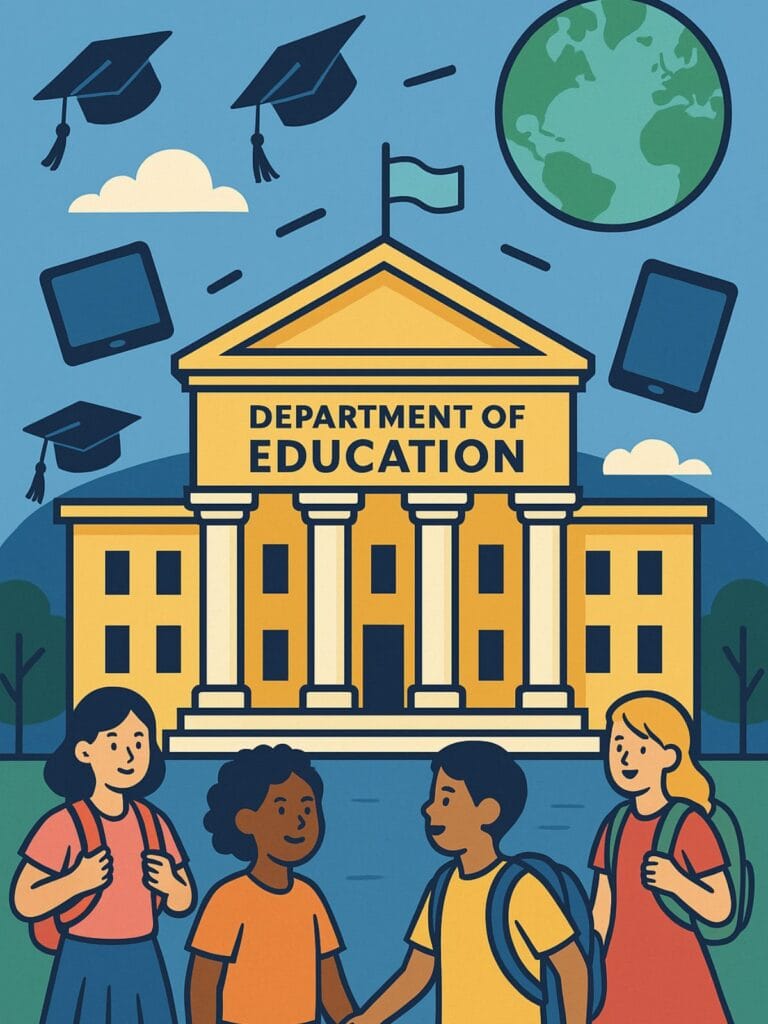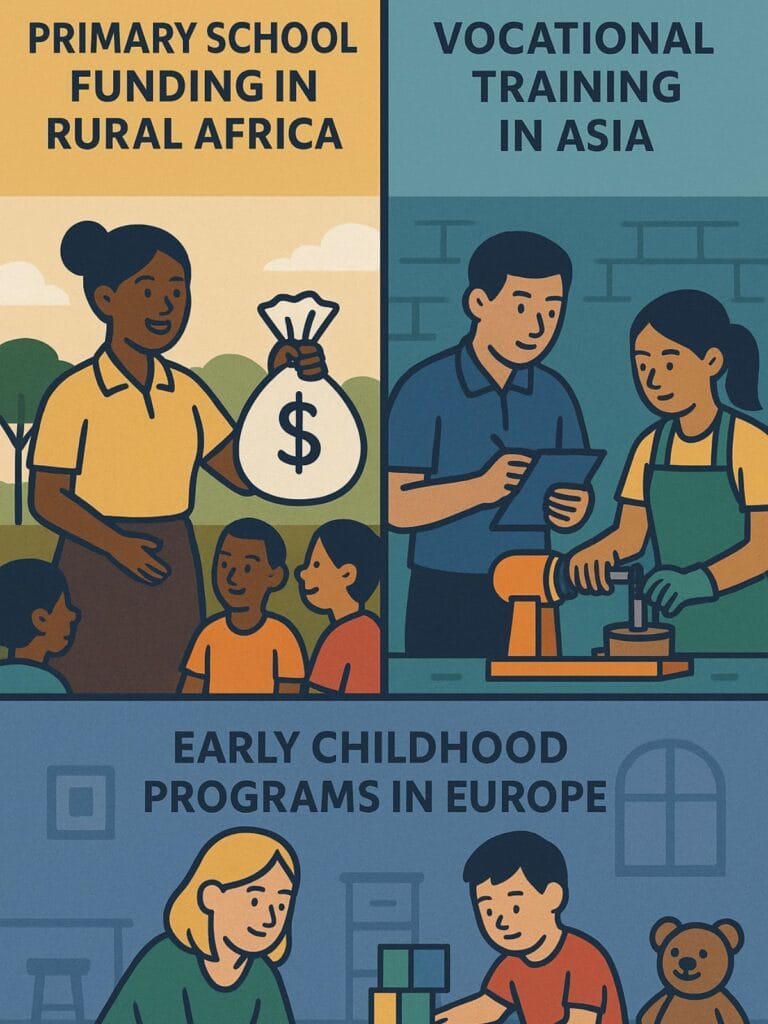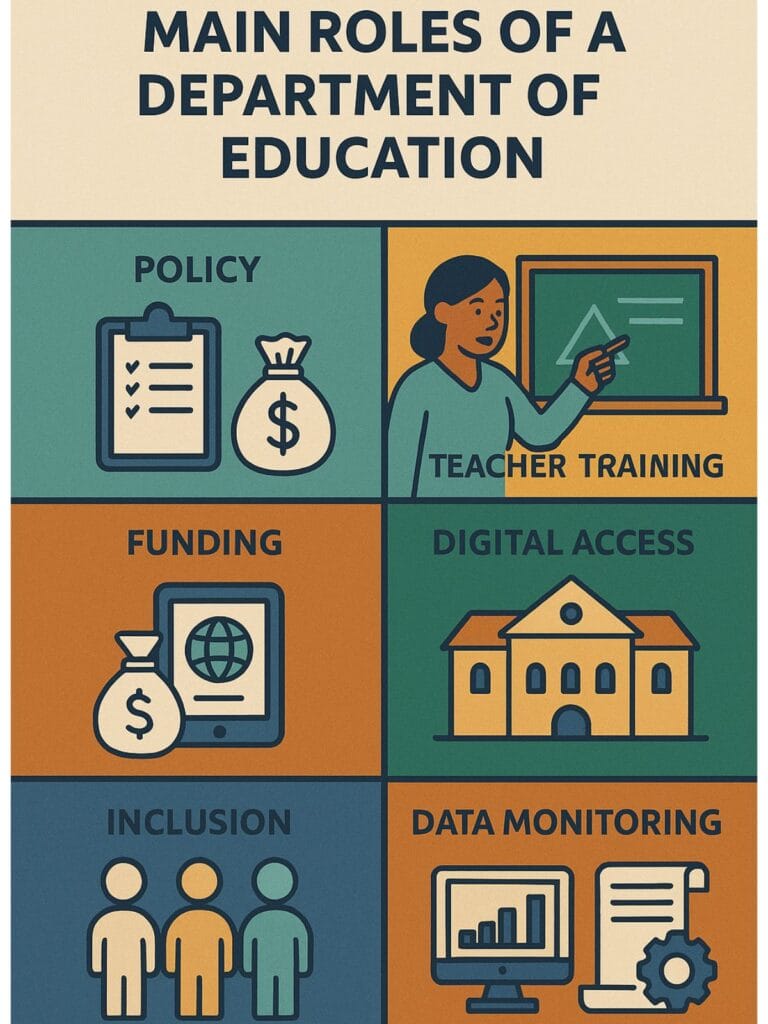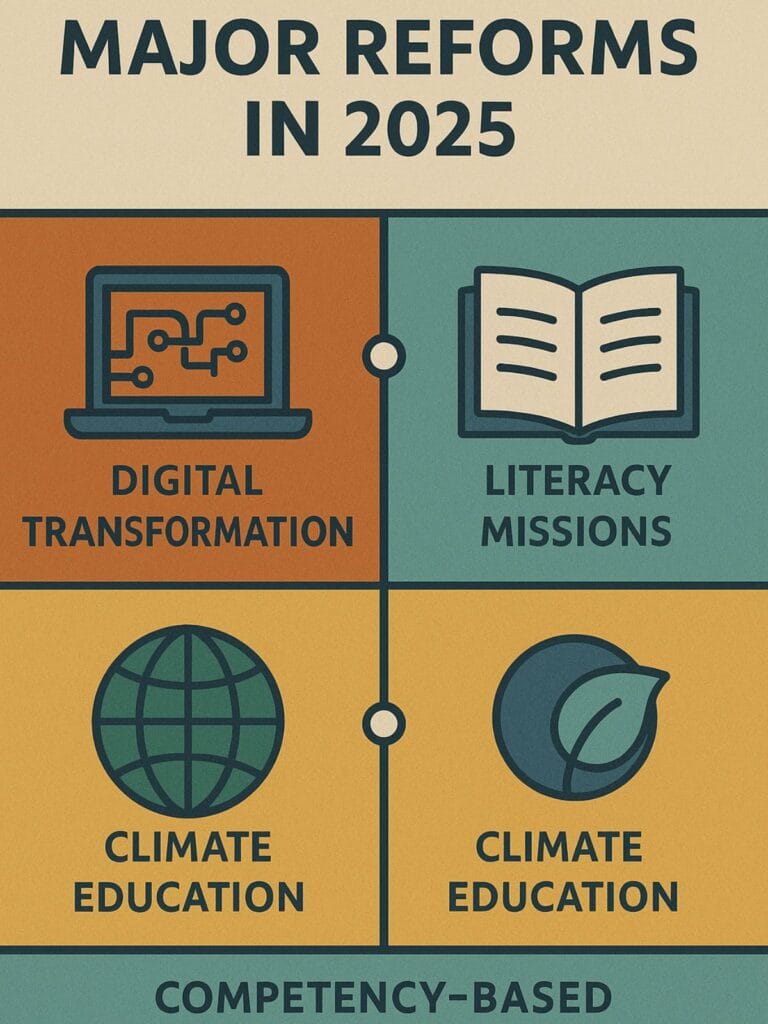Introduction: Why Every Country Needs a Strong Department of Education
Education is the bedrock of success for individuals and of development for nation-states. All countries, from the United States of America to India, from Kenya to Australia, have Departments and Ministries of Education that operate to provide access to high-quality learning.
By 2025, national ‘slices’ of education systems across the globe are responding to digital disruption and innovation, equity-driven policies, and workforce-aligned curricula. This guide explains what departments and ministries do, how they impact daily learning, and why they are important.

What Is a Department or Ministry of Education?
A Department of Education (also called a Ministry of Education in many countries) is the national body responsible for planning, regulating, funding, and improving the education system.
Key Global Functions:
- Curriculum standards
- Training beginning and experienced teachers
- Management of national assessments and examinations
- Funding of schools, colleges, and universities
- Scholarships and student loans
- Inclusive and equitable education
Countries will adapt these functions as needed based on their local circumstances and resources and strategic development goals.
Why Education Departments Matter Worldwide
No matter what its called (Ministry of Education, Ministry of Basic Education, Education Bureau), an Education Department is essential in making sure that:
- Children attend school
- Teachers are professionally prepared
- Resources are distributed equitably
- National education goals are achieved
In 2025, the education departments around the globe will be facing new global issues – and new opportunities to make positive change.
Global Responsibilities of Education Departments in 2025
1. Curriculum Design and Policy
- There will be needs to revise subject areas that include digital skills, global competence, and sustainability.
- There will be requirements that include AI, coding, entrepreneurship, and climate education.
2. School Infrastructure
- There will be opportunities to increase classroom access in remote and rural locations.
- There will be budgets to provide safe, inclusive, and technology-enabled school environments.
3. Equity in Education
- There will be mandates to ensure marginalized groups such as girls, refugees and those with disabilities can equally learn.
4. Digital Transformation
- There will be access to broadband internet, devices, and digital learning platforms.
- There will be training for all teachers to provide blended learning.
5. Teacher Recruitment and Professional Learning
- There will be need to address global teacher shortages.
- There will be offers to incentivize training and professional development opportunities.

Top Programs Offered by Departments of Education Worldwide
1. Free Primary and Secondary Education
Many countries have implemented guaranteed access to primary and secondary education through programs such as:
- India – Right to Education Act
- Kenya – Free Day Secondary Education
- South Africa – No-Fee School/Pupil Policy
- Brazil – Fundeb (Federal School Fund)
2.Financial Support for Students
- Financial support for students by governments includes programs such as:
- Government scholarships for higher education
- Student loan programs for post-secondary or technical education
- School feeding programs for disadvantaged families and students
3. Early Childhood Education Programs
Examples of preschool/pre-primary education programs are expanding in:
- Canada – Early Learning Framework
- Australia – Preschool Funding Reform
- Ghana, Free KG policy
4. Vocational and Technical Education
- Employability-focused learning through programs that are vocationally and technically oriented, including:
- Germany’s dual training system, TVET program in ASEAN, T-Levels in the U.K.

How Departments of Education Are Promoting Equity
By 2025 Inclusive education is a top priority world-wide, with strategies including:
- Gender equity policies focused on girls education
- Disability inclusive classrooms using assistive technology
- Multilingual education for ethnically diverse populations
- Conflict sensitive education in contexts afflicted by war
International agencies such as UNESCO, UNICEF, and The World Bank are engaging with national governments in making significant progress toward closing learning gaps and reducing inequity.
Digital Learning and Innovation: A Global Movement
Technology is disrupting education systems everywhere. Departments across the globe are:
- Launching nation-wide, digital learning platforms (such as Nigeria’s national e-learning platform, NELP and India’s national digital learning platform, DIKSHA)
- Training teachers to engage with Online pedagogy
- Providing devices and connectivity to disadvantaged and low-income learners
- Using AI, machine learning tools, and gamified apps in the classroom
These innovations and additions are enabling learners to prepare for a future where digital skills are a required feature.
Key Global Education Reforms in 2025
1. Emphasizing foundational literacy and numeracy
- Programmatic initiatives, such as India’s NIPUN Bharat, Kenya’s TUSOME, and Rwanda’s Literacy Boost, are focused on building students’ foundational reading and numeracy skills.
2. Lowering dropout rates
- Higher dropout rates are linked to conditional cash transfers to the family, or flexible school models or both that give children the opportunity to stay in school.
3. Competency-based education
- Greater emphasis on building real-world skills than rote learning.
- Adopted in Finland, South Korea, New Zealand, and Rwanda.
4. Climate Education
- Countries such as Sweden, Costa Rica, and the Philippines now include environmental education as part of the core curriculum.

How education departments engage with each other globally
In today’s shared and collaborative education system, Ministries of Education are working with:
- UNESCO (standard setting and research)
- OECD (global assessments such as PISA)
- World Bank (funding and policymaking)
- Commonwealth of Learning (open distance learning)
This allows small or developing countries to also be included in best practices globally.
The Role of Parents and the Community
No Department of Education can work in isolation. Support from the Community is important. Across the globe, parents are involved in:
- School boards and PTA associations
- Tracking and monitoring learning monitoring achievements
- School development planning
- Promotion of girl’s education and reduction of child labour
Some of the Common Challenges Globally
Many challenges remain, despite positive strides:
- Funding (predominantly in low-income countries)
- Lack of infrastructure, many schools have no electricity or toilet facilities
- Political instability, affecting education services in war zones
- The global learning crisis– a staggering 70% of 10-year-old boys and girls in low-income countries cannot read a simple text
Departments of Education are addressing these issues through: better planning, smarter use of data and developing partnerships.
Goals for Global Education Indicated by SDG 4
All countries gave their commitment to Sustainable Development Goal 4 (SDG 4):
“Ensure inclusive and equitable quality education and promote lifelong learning opportunities for all,
The ambition is for all departments or ministries of education by 2030 to have: at least
- Free primary and secondary education
- Equitable access to quality pre-primary education
- Gender parity
- Skills development for employment
What the Future Holds: 2025 and Beyond
By 2025, most education departments hope to be able to:
- Full digitization of learning systems
- Have a 30 % lower drop out rate
- Create inclusive classrooms in every district
- Increased funding for teacher salaries, and digital skills training
- Program Expansion: Technical and vocational education
The future will be centered around flexible hybrid and skills-based learning to prepare students for a digital and globalized economy.
Conclusion: The Department of Education: The Backbone of National Development
From Nairobi to New Delhi, Toronto to Tokyo—there is no more powerful institution than the Department or Ministry of Education, helping to shape the minds of youth and directing the futures of nations.
These institutions are changing to adapt to the new realities and challenges of today, with innovation, cooperation, and a commitment to equity. Decisions made by such institutions determine what students learn, how teachers teach, and how nations compete in a knowledge economy.
Education is a right for all, and a national responsibility for all.
External Resource Links:
- UNESCO – Education 2030 Agenda
- World Bank Education Overview
- Global Partnership for Education (GPE)
- OECD Education Policy Outlook
- UNICEF Global Education


